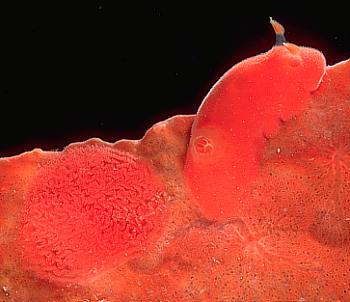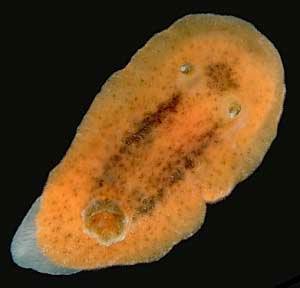

Rostanga bifurcata
Rudman & Avern, 1989
Order: NUDIBRANCHIA
Suborder: DORIDINA
Family: Dorididae
DISTRIBUTION
This species has a wide Indo-West Pacific distribution with records presented here from both the east and west coasts of Australia, Singapore, Hong Kong and Tanzania.
PHOTO
UPPER: Animal, (25mm long) with egg ribbon, on food sponge, Antho chartacea, AM C150065, Kurnell, Botany Bay, Sydney, May 1986.
LOWER: yellowish colour form, Jervis Bay, New South Wales, Australia, 18 mm long alive, AM C144049. PHOTOS: Bill Rudman.
See also R. bifurcata - Radula.
See also R. bifurcata - Anatomy.
The mantle and body are usually bright red with a close covering of red caryophyllidia. In specimens from Botany Bay, Sydney, there are variations in background colouring with some specimens having patches of brown specks on the mantle epithelium and some having white patches or irregular lines, the white pigment being on the caryophyllidia. Most specimens though are uniformly red. Other specimens from Sydney have an indistinct white reticulate pattern and specimens from southern New South Wales had a pale reddish orange background colour with a distinct pattern of brown patches. Bright red specimens from the Great Barrier Reef had irregular white streaking on the mantle while specimens from Tanzania and Hong Kong had small brown specks scattered over the mantle. In all specimens mantle glands appear to be restricted to a broad band of small white specks at the mantle edge. The rhinophore stalk is translucent clear and the club is usually the same colour as the mantle but with the upper third being white or having white patching. There is usually some brown dusting on the rhinophore lamellae. The gills are a translucent red matching the background colour of the mantle. The main blood vessel on the inside face of each gill is often white, or has some white dusting clearly outlining the branching on the gill.
The body is similar in shape to R. arbutus but the spicules forming a subterminal ring in the caryophillidia are not as prominent as in that species. The rhinophores are relatively long and the club tapers to a slender stalked knob at the tip. The rhinophore lamellae lie almost horizontally but slope downwards posteriorly. There are seven to ten gills arranged in an upright circle around the anal papilla. The gills are tripinnate but each pinnule and its secondary branches are shaped so that each gill has a very regular outline with a low rounded tip.
The egg ribbon has only been observed for New South Wales specimens. It consists of large multi-spiralled ribbon of microscopic red eggs. The ribbon is thrown into tight folds along its free end. From personal observations and those of Hunter & Woodward (personal communication) development is planktotrophic, possibly lecithotrophic, small swimming veligers hatching from the egg mass nine days after deposition.
Sublittoral specimens from Sydney Harbour and Botany Bay are only found on a large erect plate-like poecilosclerid sponge Antho (Isopenectya) chartacea (Whitelegge, 1907) (Family Microcionidae). They feed and lay their egg masses on this sponge. However, as this sponge is not found intertidally it is probable that intertidal specimens feed on other species of sponge. As this is the first record of Antho chartacea since its original description from Sydney Harbour, we do not know whether it is present throughout the range of R. bifurcata.
Reference:
• Rudman, W.B., Avern, G. (1989) The genus Rostanga (Nudibranchia: Dorididae) in the Indo-West Pacific. Zoological Journal of the Linnean Society 96(3): 281-338.
Rudman, W.B., 2002 (February 5) Rostanga bifurcata Rudman & Avern, 1989. [In] Sea Slug Forum. Australian Museum, Sydney. Available from http://www.seaslugforum.net/factsheet/rostbifu
Related messages
-
Rostanga from New Caledonia
From: Jean-François Hervé, August 31, 2006 -
Rostanga bifurcata from Hong Kong
From: Bill Rudman & Brian Darvell, February 8, 2002 -
Rostanga bifurcata from Coffs Harbour
From: Bill Rudman, February 8, 2002 -
Rostanga at Fly Point
From: David & Leanne Atkinson, January 9, 1998
